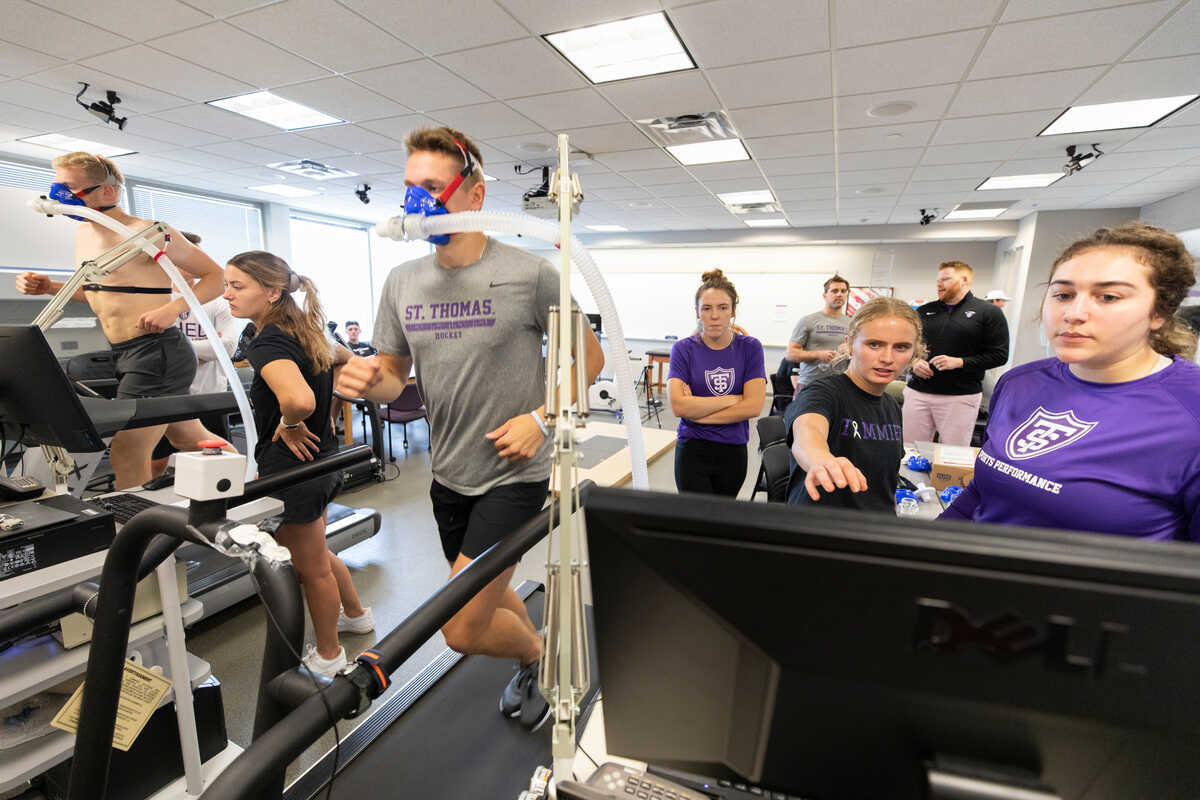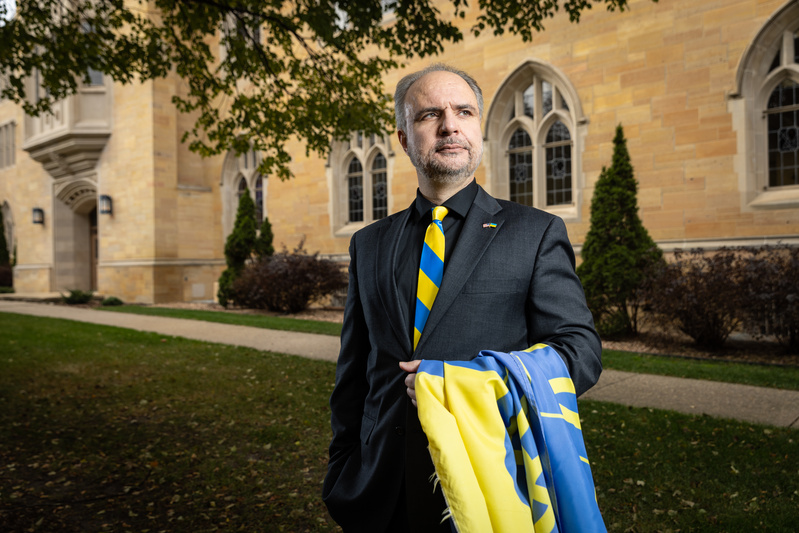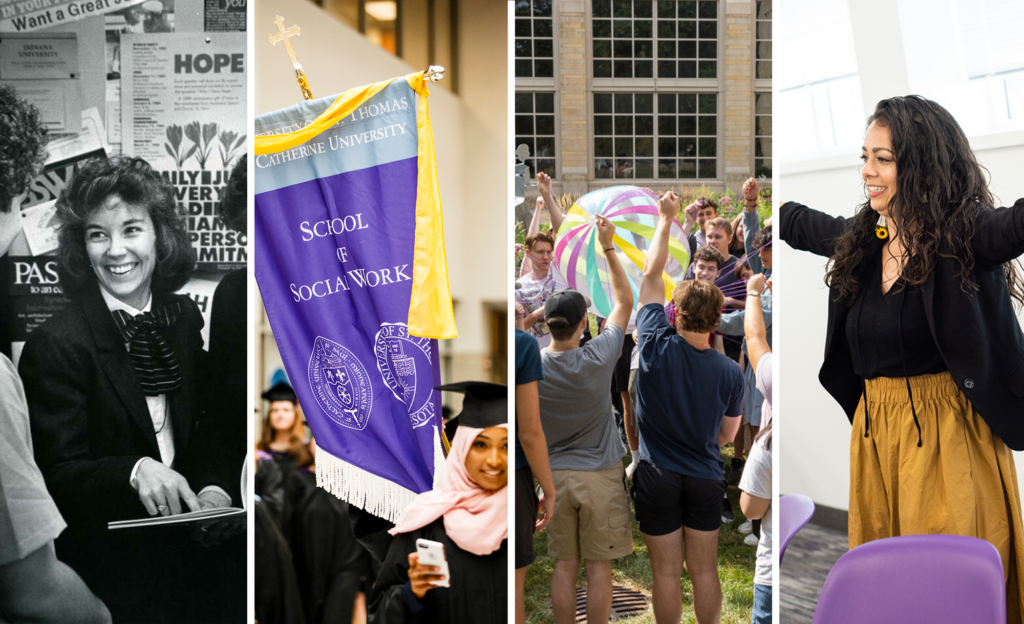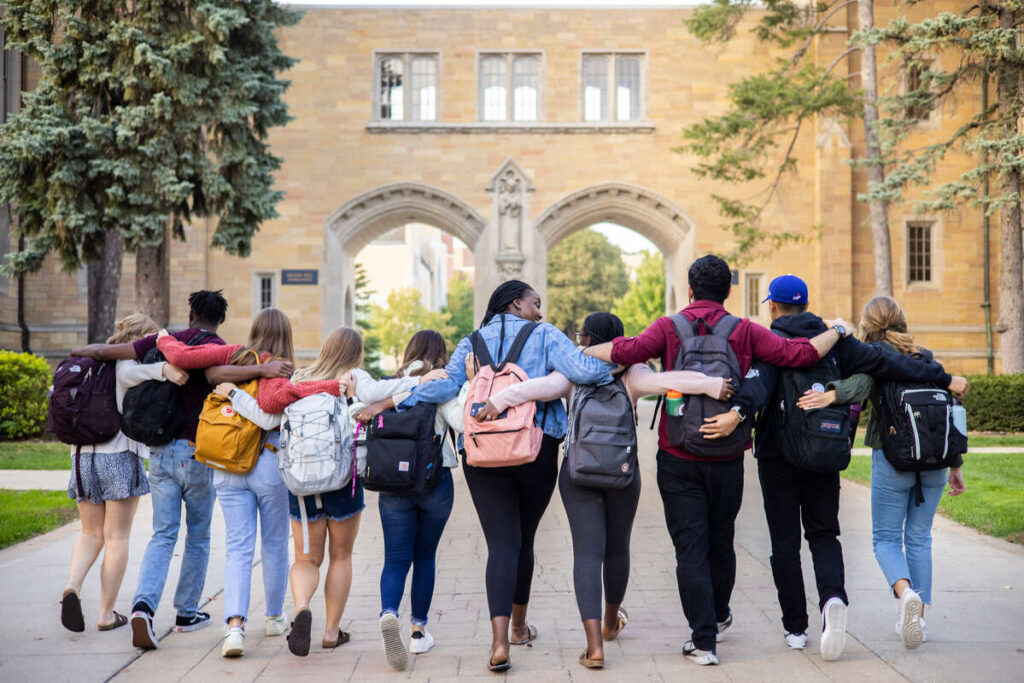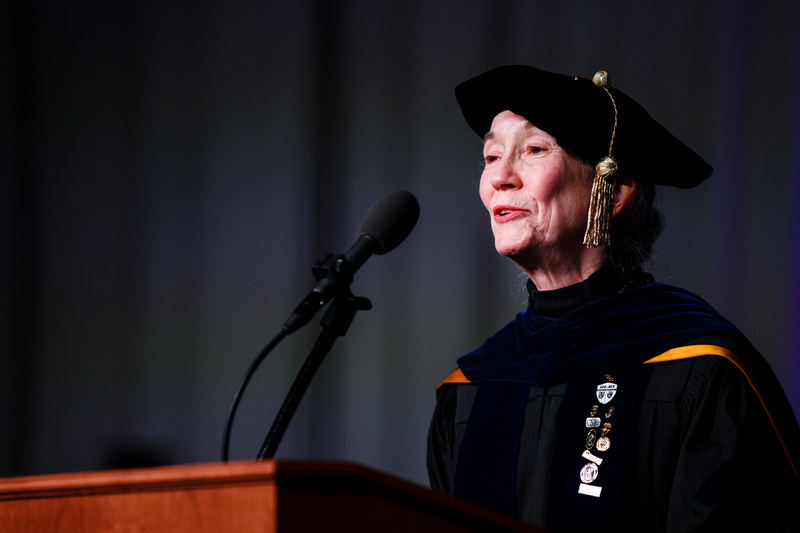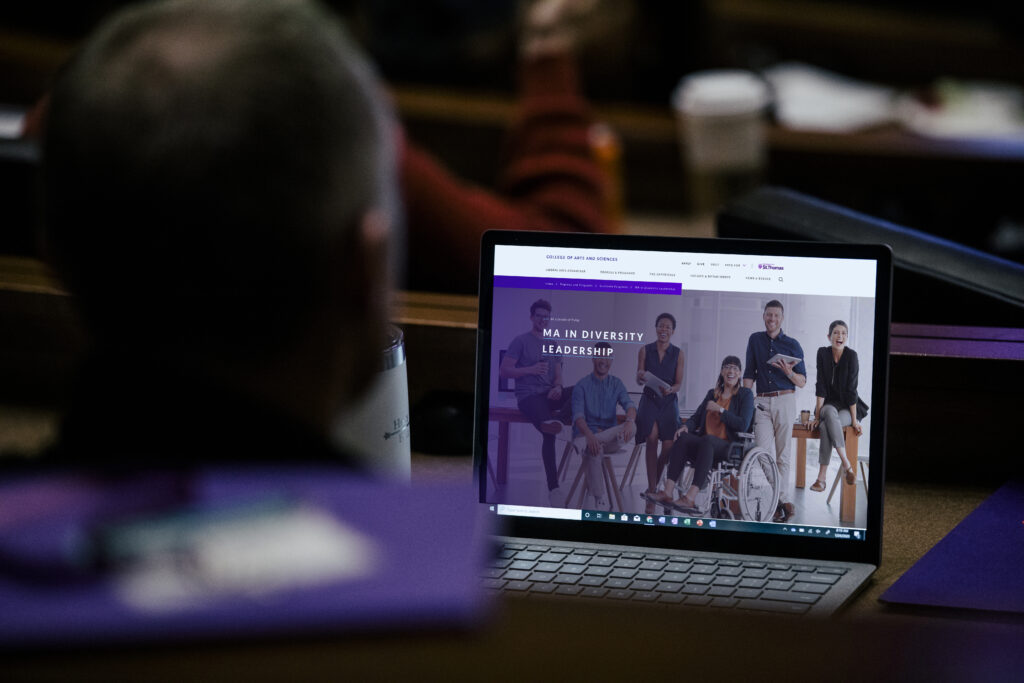It goes without saying that student-athletes at the University of St. Thomas have a drive to compete. But if you visit the second floor of the Anderson Athletic and Recreation Complex, you’ll discover a laboratory that is a secret weapon giving them an edge: The Sports Science Institute.
Inside this institute, depending on the season or day of the week, you may find student-athletes from a number of teams – soccer, basketball, or hockey, just to name a few. But look more closely and you’ll notice there’s another team in the room and this laboratory is their court. The home court advantage goes to health and exercise science students.
A division of the Department of Health and Exercise Science, the Sports Science Institute is the only known program in the country that offers undergraduate students the opportunity to work alongside current Division I student-athletes, tracking their vitals.
Exercise science major Garrett Barten ’23 is a member of this sports science team. This year, he has stood faithfully by dozens of Tommie student-athletes who have entered the lab.
“It’s awesome to be able to learn about these tests, like in our exercise physiology classes and then to be able to actually take what we learn in that class … and apply it to actual students and actual athletes,” Barten said.
On one fall day at the Sports Science Institute, although there is no ice rink in sight, the enthusiasm of the men’s hockey team echoes through the room. The players have made the day’s task the ultimate competition between peers. Barten coaches each through a VO2 max test, encouraging them to perform at their absolute best, keeping safety in mind above all else.
“These athletes have a crazy drive to compete,” Barten said. “And their desire to get data from us is incredibly cool.”
Innovative collaboration
The Sports Science Institute (SSI) is a fairly new addition to the Morrison Family College of Health. It was in 2021 when the partnership between Athletics and the Department of Health and Exercise Science (HES) became official. But that new car smell has hardly kept participants at bay, as the department’s students, coaches and student-athletes clamor to take part in what is truly an innovative collaboration.
“The uniqueness is just a big thing for us,” said Paul Mellick, chair of HES and leader of SSI. “This feels really novel – undergrads who are running a sports science program at a Division I school.”
That uniqueness has led to a rapid expansion. What started with the men’s hockey team has expanded to seven teams, now including swim and dive, men’s and women’s basketball and women’s soccer. This fall, women’s cross country as well as track and field were added to the list.

Along the way, each team has gained invaluable data tracking their student-athletes, while undergraduate students on the SSI team gain experience working with those same athletes. For many health and exercise science majors, their goal is to someday work with professional athletes as a career. For Barten, he’s been afforded the chance to take his studies far beyond the charts and projections of classroom work.
“I’ve learned so much, from basic communication skills with the athletes to being able to have them follow through with our plans,” Barten said. “My ability to direct athletes has gotten way better.”
Each step of the way, students work with St. Thomas athletic trainers to hone their skills and learn from professionals.
“Our student-athletes and our students on campus gain insight to injury risk reduction, how they can evaluate their progress, and it’s an opportunity for learning,” said trainer Jamie Jaeger. “This is a perfect opportunity to educate students with hands-on, real-life experience.”
In addition to the VO2 max testing, which measures aerobic capabilities, the SSI team has a wide range of tools at their disposal. Dual X-ray absorptiometry can measure bone density. Polar team pro sensors can monitor heart rate, calories burned, and distance covered in practice.
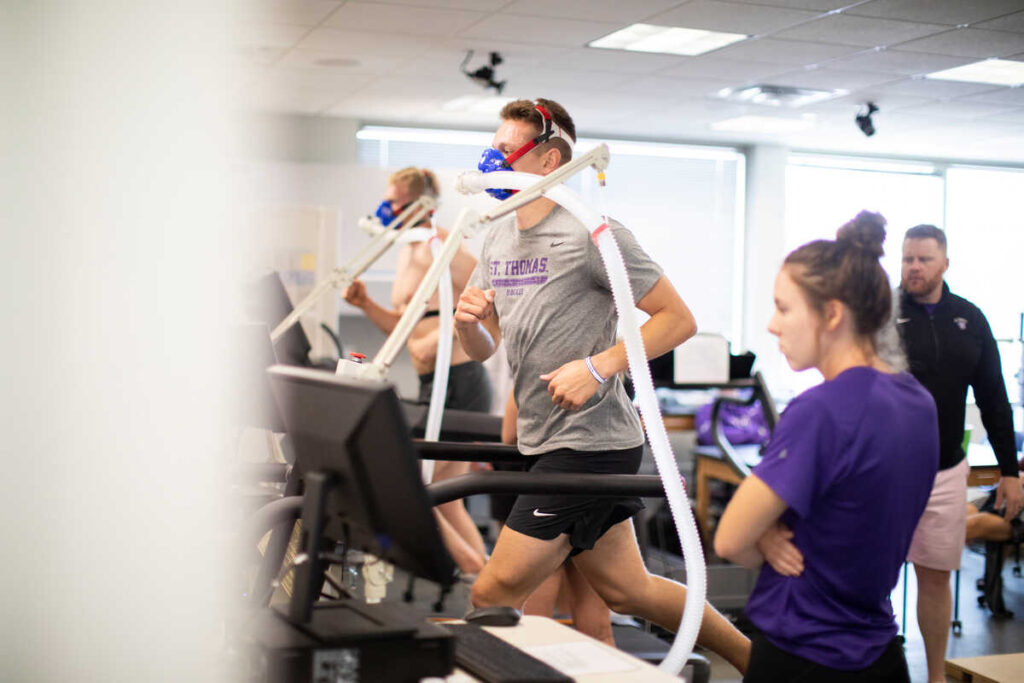
Raising the bar for Athletics
Women’s basketball coach Ruth Sinn is fully on board.
“Who doesn’t want to know about themselves?” Sinn asked. “They always talk about how much everyone enjoys psychology classes. Well, yeah, it’ s because you’re talking about yourself.”
In this case, talking more about themselves is giving the women’s basketball program an edge.
“They’re providing us insight into what our student-athletes are already doing and how to become more efficient,” Sinn said. “Knowledge is power and we’re using this knowledge to be much more precise in the way that we train, and the way that we approach training.”
This year the women’s basketball team will wear Polar sensors through a variety of practices and games, relying on the SSI team to break down the data on everything from individual workouts to trends across an entire season.
Maggie Negaard ’23 is an elementary education major and guard on the women’s team. She’s excited to work with coaches as they make real-time adjustments in response to what they learn.
“This data has been really beneficial for our bodies to last through a really long basketball season,” Negaard said. “College athletes have a very busy schedule, and there’s a lot of stress. There’s a lot going on, so using this data will be beneficial for the all-around athletic experience.”
That data will even come into play several years down the road.
“We get to tell them, ‘Here's how your entire body is changing over the course of your time at St. Thomas as a student-athlete,’” Mellick said. “It gives student-athletes a picture of what happens to them from their first year all the way through their senior year.”

Building a partnership for the future
As the Sports Science Institute strengthens its relationship with Athletics, opportunities to build on their collaboration continue to come into view. On the horizon, more teams are expected to participate. Meanwhile, the SSI team hopes to grow the kinds of data they can collect with new technology. Right now, they have their eye on a skating treadmill and cycle ergometer.
“The partnership with Athletics and their teams has just been great,” Mellick said. “It’s been a really beneficial way to integrate the athletic side of the university with the academic side.”
That’s a sentiment seconded by coach Sinn. She’s planning to foster their side of the partnership for as long as possible.
“Our university is all about the common good and how do we serve one another. And this really shows that it’ s not Athletics going Division I on their own,” Sinn said. “This is about Athletics and academics partnering together and growing each other in different ways.”
Back in the laboratory, Garrett Barten is getting ready to apply to graduate schools for exercise science. Working with Division I student-athletes is not something he’ll forget anytime soon.
“The fact that we're Division I now and we have the ability and the funding to be able to do this with the athletes, it’s an awesome opportunity,” Barten said. “It’s definitely a much better way to learn.”
